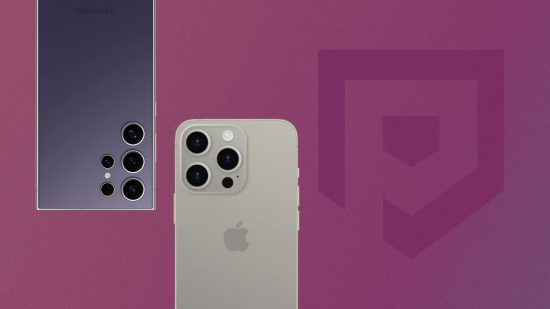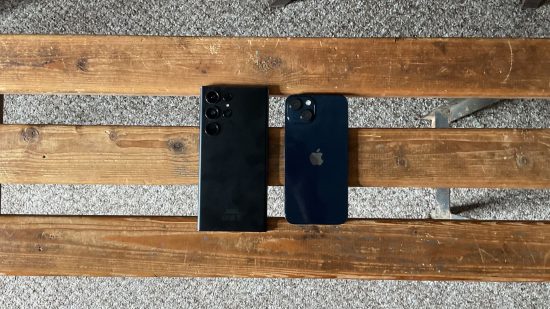The iPhone vs. Samsung debate is one that just isn’t going away. In fact, it gets more intense each year, with both brands leveling up their software and hardware to compete at the top of the market. This year, for instance, it’s been the battle of the Samsung Galaxy S24 Series up against the iPhone 15 Series, and it’s been another closely contested one. It’s been this way since the start of the smartphone era, and we don’t expect it to change any time soon.
While we can’t offer a concrete answer to which brand is better, that’s subjective after all, we can lay it all out on the table for you to decide. In this guide, we’re going to delve into the components, gaming performance, and services available with different devices from each brand, so you can leave with a better idea of what might suit you best before the launch of the iPhone 16 later this year.
Why you can trust our advice ✔ At Pocket Tactics, our experts spend days testing games, phones, tech, and services. We always share honest opinions to help you buy the best. Find out how we test.
So, here are our main comparison points as we answer, iPhone vs. Samsung, which is better for gaming?
Chipset
When it comes to the iPhone vs. Samsung argument, the best place to start is with the processing power of each phone. As you might assume for industry-leading devices, both brands utilize some pretty powerful chipsets, but there’s a very different approach between the two.
Apple manufactures its own chipsets. The latest is the A17 Pro, which powers the current flagship iPhone 15 Pro Max and 15 Pro models. The iPhone 15 and 15 Plus utilize the same chipset as the 14 Pro Max and 14 Pro, the A16 Bionic. Despite a generation between them, both are more than capable of high-end gaming, giving Apple another point in the battle against competitors.
In all honesty, the difference between the A17 Pro and the A16 Bionic is nominal. Through testing with the A16 earlier last year, we found the A16 Bionic capable of running Genshin Impact up to an impressive 59fps. The A17 Pro takes it just that little bit further, with our iPhone 15 Pro Max review praising the handset’s performance.
If you prefer to go the eco-friendly route with refurbished phones, or you’re on a bit more of a budget, the still-relevant iPhone 14 and iPhone 14 Plus models are capable alternatives to the latest devices for most mobile gamers. We’ve tried out both phones, and neither has a problem with games like Honkai Star Rail or PUBG Mobile, though the animations aren’t quite as crisp as they are on the newer iPhones.
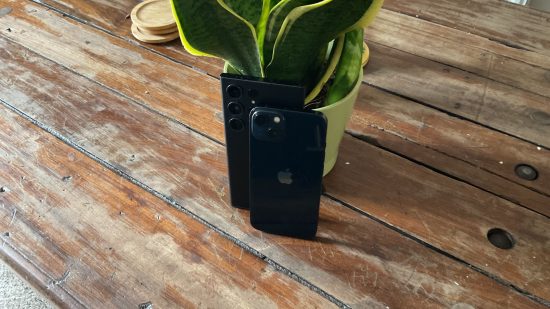
Meanwhile, Samsung’s choice of chipsets is a little more difficult to follow and depends on where you’re reading this from. In the US, Canada, and China, all three phones from the S24 series utilize overlocked Qualcomm Snapdragon 8 Gen 3 processors. However, in all other markets, only the S24 Ultra comes equipped with the Snapdragon, with the international versions of the S24 and S24+ utilizing Samsung’s own Exynos 2400 chipset.
The Exynos 2400 is a competitive chipset, but it’s not quite as powerful as the industry-leading Qualcomm alternative. However, it’s a pretty negligible difference, and one you probably won’t notice in your day-to-day gaming. Both chipsets pack enough performance firepower to run games like Honkai Star Rail, PUBG Mobile, and more with high graphics settings, which is what you’d expect from a trio of flagship smartphones in 2024.
Still, like with the iPhone alternatives, you don’t necessarily need the latest Samsung device if you’re looking for a solid gaming phone. As you can see in our Samsung Galaxy S23 review, we love the phone, and its gaming performance is still up there with the best of the best. It’s easy to forget that, at the time of writing, the S23 is only a year old, and it’s still one of the better performers you can put in your pocket.
You can find differences between the two brands at the really high end: the Samsung S24 Ultra has an even bigger vapor chamber than its predecessor to help with heat dissipation, so you shouldn’t have any problems with lengthy gaming sessions. We haven’t been able to test this, so it’s hard to give a categorical answer on the S24 Ultra versus the new iPhone 15 Pro Max in terms of keeping your device cool. Either way, you should be able to maintain gaming sessions of a couple of hours without any issues on both, but the Samsung S24 Ultra might just stay cooler for longer.
That’s on the super high end, however, and differences are definitely minute, even if they are there. That’s sort of the case for the most expensive phones the two companies offer, but where more key differences arise, is with the budget flagships. And that’s because of their displays.
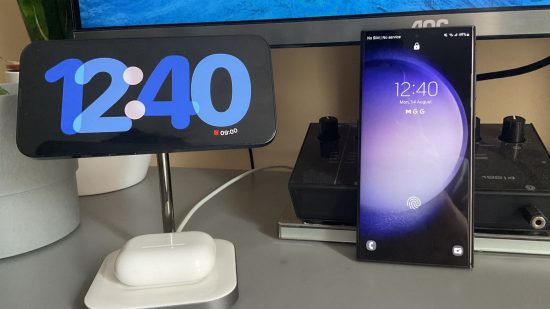
Display
Each brand’s flagship phone, the iPhone 15 Pro Max and Samsung Galaxy S24 Ultra, each has 120Hz refresh rates and OLED displays, so you’re getting the best of the best for mobile gaming whichever you go with. Both also utilize LPTO display technology, so the screen scales down the refresh rates to preserve battery if you’re running low, though this is just an option, and you can game at 120Hz until your phone runs out of juice if you want.
Comparing the iPhone 15 Pro Max and S24 Ultra is a difficult job as only the most discerning eye can tell the difference between both. There’s also our old friend subjectivity to deal with, with some naturally preferring one or the other due to brand bias or a negative experience in the past. Both premium phones offer 120Hz refresh rates, which means gaming is as smooth as can be on whichever you opt for.
Meanwhile, the iPhone 15 and 15 Plus only offer 60Hz displays. This is a substantial difference for gaming, so if you’re looking at the ~$800 price range, Samsung is definitely the way to go. The S24 Series displays are absolutely exquisite. If you’re looking at ~$1,000 or more, it’s still a tight battle, so keep reading.
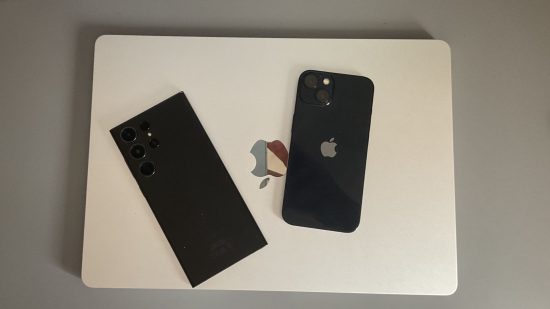
Ergonomics
The iPhone vs. Samsung battle gets a bit more complicated when it comes to ergonomics, as it’s so dependent on your subjective opinion and preferences. Still, we’ve got details on the designs of the flagship models from each below, so it’s well worth doing the research before splashing your cash on a new smartphone.
The most obvious difference between the designs of the Samsung Galaxy S24 Ultra and iPhone 15 Pro Max is in the corner. The iPhone 15 Pro Max has round corners, whereas the S24 Ultra’s are square. As someone who’s spent the last few years using an iPhone, square corners still feel a bit peculiar to me, but this is very subjective, and you might be more of a fan of Samsung’s squared-off ones. Either way, both devices are comfortable in the hand, making for even longer gaming sessions.
Meanwhile, the lower-end flagship phones are very similar. The S24 and S24 Plus have flat tops and bottoms with rounded sides, whereas the iPhone 15 and 15 Plus are flat all the way around. For me, the flat sides all the way around feel a little nicer in the hand, but again, it’s a minute difference that comes down to personal preference.
On the subject of design, Samsung offers something a little different with the Z Fold and Z Flip phones. Despite countless rumors, we’ve still not seen a foldable Apple phone, and it doesn’t look like we’re getting one any time soon. So, if you’re looking for something a little different from a regular brick phone, there’s only one winner in the iPhone vs. Samsung debate.

Services
While most of the categories we’ve looked at so far are evenly matched, when it comes to gaming services, Apple is the clear winner. With Apple Arcade, and the countless number of Apple Arcade games, the Cupertino company offers something Samsung doesn’t, and we’re big fans of it here at Pocket Tactics.
While Apple Arcade is a fantastic service, and more games arrive on it every month, the downside of the iPhone is that it doesn’t play nice with APKs. You have to download everything from the App Store, there’s no way around it without jailbreaking your phone, and we really don’t recommend that. However, in 2024, we’ve started to see a swathe of emulators arrive on the App Store, which takes away from one of Samsung’s big selling points.
Still, as Samsung runs Android, the benefit of downloading apps from many different places is still a big boon. As we explain in our iPhone vs. Android guide, this is great if you know what you’re doing, and you can get all manner of classics up and running in the palm of your hand. Be warned, however, that if you’re not certain you’re doing it safely, it’s best to avoid it. Do not download things from a site unless you know it’s safe.
It’s possible this head-to-head might have a different result in the near future, though. The Samsung Gaming Hub is currently only for Samsung smart TVs, but there are rumors that the company intends to bring something similar to smartphones before too long. If this happens, we may have to readjust our thinking in terms of gaming services. Still, for now, the Apple devices continue to reign supreme.
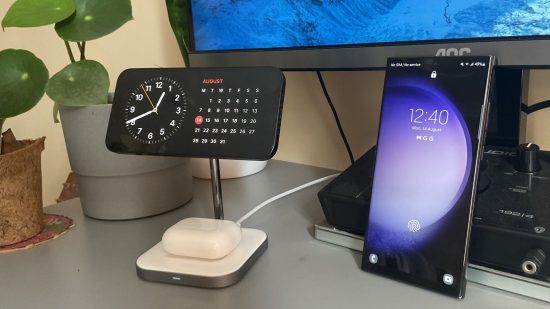
Which is better for gaming, iPhone or Samsung?
With all of that in mind, we come back to our original question – which is better for gaming, iPhone or Samsung? While it’s a close call between the two, and much is the subject or personal preference, we believe that Samsung is the best for gaming at the time of writing. With generally better displays and competitive performance, Samsung phones are excellent for mobile games.
Still, it’s the flexibility of Android that makes it our pick for the better phone for gaming. With just a little research, you can utilize your Samsung to play anything from the latest high-quality mobile title to that PS1 game that gives you the warm nostalgia fuzzies. While the introduction of emulators to iOS has turned our heads a little, the customizability of the Samsung ultimately still wins out.
This by no means iPhone is a bad choice, however. Apple Arcade is unbeatable at the moment, despite reports that the gaming service might be struggling behind the scenes. And, if you’re going for the top-end flagships, the difference versus Samsung is nominal. Just know, you’re not going to play any PS1 games unless they launch on the App Store.
While we have Samsung down as the winner at the time of writing, that could all change in the not-so-distant future. However, with what we’ve seen of the gameplay experience from both, Samsung just edges out the Apple device, though there are plenty willing to disagree with that statement. Both smartphones are so capable that it really comes down to subjective opinion, but hopefully, we’ve given you a better idea of what to expect from each.
So, there you have it, iPhone vs. Samsung in a gaming battle for the history books. Of course, the best foldable phones also offer a different gaming experience – and that’s a market that Samsung dominates, while Apple does not partake. So, if you fancy a foldable, check out that guide.
For more beyond iPhone vs. Samsung, we’ve also got a list of the best gaming phones and the best power banks to keep them full of juice. For other platforms, check out the best portable gaming consoles, where Nintendo Switch and the best iPad share the stage with countless other handheld heroes.
